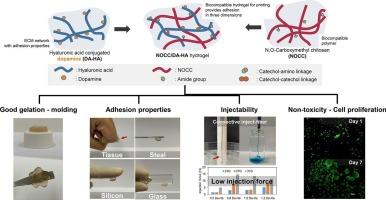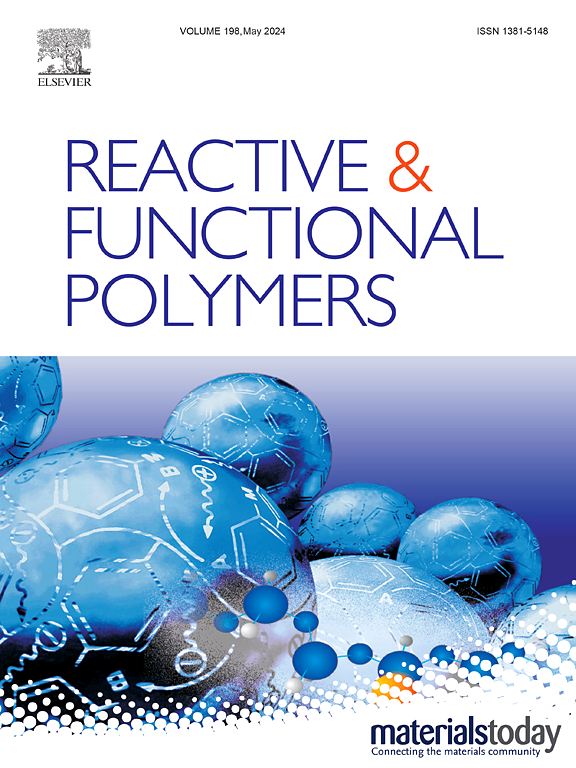Design of a non-oxidative adhesive dopamine-grafted hyaluronic acid/NOCC hydrogel for enhanced cell spheroid formation and soft tissue regeneration
IF 4.5
3区 工程技术
Q1 CHEMISTRY, APPLIED
引用次数: 0
Abstract
Tissue adhesive hydrogels from dopamine represent a compelling material with diverse applications across engineering and medical fields. Although numerous designed adhesive hydrogels have been developed, significant limitations have arisen from the reliance on hydrogen peroxide as an activating agent for crosslinking hydrogels. To address this, our study investigates an innovative approach to create an adhesive and biocompatible hydrogel from dopamine conjugated-hyaluronic acid (Da-HA) and N, O-Carboxymethyl Chitosan (NOCC) without the need for oxidative agent treatment for use in biomedical engineering application. The reactions were performed under mild alkaline conditions, vigorous stirring, and curing, resulting in DHC hydrogels. Proper modification and reactions in the hydrogel matrix were confirmed by NMR spectroscopy and Fourier transform infrared spectroscopy (FTIR). The gelling and tissue adhesive properties of the produced DHC hydrogel are proportional to the Da-HA content in the hydrogel. Scanning electron microscopy revealed changes in pore walls among samples and pore diameters ranging from 100 to 300 nm. Rheological analysis demonstrated a high visco-elastic material and self-healing properties. Importantly, the growth of L929 cell spheroids was noted upon their cultivation atop the designed hydrogel. The material holds significant promise for 3D printing and cell encapsulation therapies, as well as in situ tissue repair, particularly for mechanically dynamic tissues like the dermis.

设计一种非氧化粘附性多巴胺接枝透明质酸/NOCC 水凝胶,以增强细胞球体形成和软组织再生能力
多巴胺组织粘合水凝胶是一种引人注目的材料,可广泛应用于工程和医学领域。虽然已开发出许多设计的粘合水凝胶,但由于依赖过氧化氢作为交联水凝胶的活化剂,因此存在很大的局限性。为了解决这个问题,我们的研究采用了一种创新方法,利用多巴胺共轭透明质酸(Da-HA)和 N,O-羧甲基壳聚糖(NOCC),在生物医学工程应用中无需氧化剂处理就能生成具有粘合性和生物相容性的水凝胶。反应在弱碱性条件下进行,剧烈搅拌并固化,最终得到 DHC 水凝胶。核磁共振光谱和傅立叶变换红外光谱(FTIR)证实了水凝胶基质中的适当改性和反应。所制得的 DHC 水凝胶的胶凝和组织粘合性能与水凝胶中的 Da-HA 含量成正比。扫描电子显微镜显示,不同样品的孔壁发生了变化,孔径从 100 纳米到 300 纳米不等。流变学分析表明,这种材料具有高粘弹性和自愈合特性。重要的是,在所设计的水凝胶上培养 L929 细胞球体时,发现它们在生长。这种材料在三维打印和细胞封装疗法以及原位组织修复方面大有可为,尤其适用于像真皮这样的机械动态组织。
本文章由计算机程序翻译,如有差异,请以英文原文为准。
求助全文
约1分钟内获得全文
求助全文
来源期刊

Reactive & Functional Polymers
工程技术-高分子科学
CiteScore
8.90
自引率
5.90%
发文量
259
审稿时长
27 days
期刊介绍:
Reactive & Functional Polymers provides a forum to disseminate original ideas, concepts and developments in the science and technology of polymers with functional groups, which impart specific chemical reactivity or physical, chemical, structural, biological, and pharmacological functionality. The scope covers organic polymers, acting for instance as reagents, catalysts, templates, ion-exchangers, selective sorbents, chelating or antimicrobial agents, drug carriers, sensors, membranes, and hydrogels. This also includes reactive cross-linkable prepolymers and high-performance thermosetting polymers, natural or degradable polymers, conducting polymers, and porous polymers.
Original research articles must contain thorough molecular and material characterization data on synthesis of the above polymers in combination with their applications. Applications include but are not limited to catalysis, water or effluent treatment, separations and recovery, electronics and information storage, energy conversion, encapsulation, or adhesion.
 求助内容:
求助内容: 应助结果提醒方式:
应助结果提醒方式:


